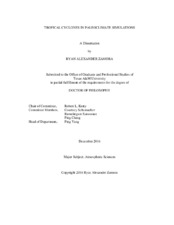| dc.description.abstract | This research examines tropical cyclones in simulations of climates very different from modern. The tropical cyclones are simulated via two techniques: explicitly tracking TC-like structures in global climate model output, and by downscaling model output to be used in higher resolution models able to resolve tropical cyclones. These techniques are applied to climates such as the Last Glacial Maximum, mid-Holocene, and in a suite of simulations that feature very hot surface temperatures forced by higher global concentrations of CO2. The simulated tropical cyclone climatologies are compared with the large-scale environmental factors within these climates, in an effort to extend the knowledge of the tropical cyclone response across varying climate conditions.
Explicitly resolved storms within CCSM4 did not relate well to a common set of environmental factors across 20th century and LGM climates, and in addition showed that changes in climate are potentially sensitive to the inclusion of the weakest systems, which are controlled by the choice of threshold detection criteria. Sensitivity tests conducted on these storms showed that altering the surface wind speed threshold an initial disturbance must achieve by as little as 20% significantly alters the overall result (showing a greater number of 20th century or Last Glacial Maximum storms generated depending on this choice).
We show that the storms generated via Emanuel’s downscaled storms technique relates well in each of the climates to a combination of environmental factors important for TC genesis and development, such as genesis potential and ventilation indices. Regional and temporal changes in these large-scale factors well predict changes in tropical cyclone activity between the different climates. In addition, these storms show relationships in intensity and genesis with warming, particularly with the strongest storms generated. | en |


